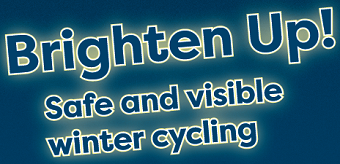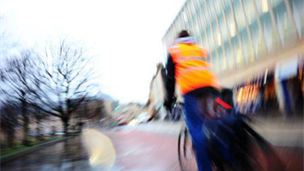Brighten Up!
With the clocks going back by one hour in late October it's important for cyclists to Brighten Up.

It isn’t just about cyclists and pedestrians being seen though - car drivers have a responsibility to give other road users space and time.
This guidance (based on a leaflet previously produced by the Department of Transport, AA and CTC) aims to make motorists and cyclists more aware of one another, to help both stay safe on the roads - on campus and beyond.
Cyclists may also want to take a look at:
What cyclists would like motorists to know
- Cyclists are more vulnerable than motorists - drivers have the major responsibility to take care. Rain, wind and poor visibility make conditions worse for cyclists.
- Cyclists can feel threatened by inconsiderate driving. They have a right to space on the road and need extra room at junctions and roundabouts where cars change speed, position and direction.
- Cyclists ride away from the kerb, not to annoy motorists but to:
- Avoid drains, potholes and debris
- Be seen as they come to junctions with side roads
- Discourage drivers from squeezing past where it is too narrow
- Cyclists turning right are exposed - and need extra consideration from motorists, especially on multi-lane roads with fast-moving traffic.
- Cyclists can be forced into fast traffic - by vehicles parked in cycle lanes, at junctions or on double yellow lines.
- Cyclists are dazzled by full-beam headlights, like everyone else.
- Cyclists can be fast movers - 20 mph or more.
What motorists would like cyclists to know
- Motorists get upset if cyclists ride without lights at night, ignore red traffic lights or hop on and off the pavement.
- Motorists usually travel faster than cyclists and may have less time to take account of hazards.
- Motorists may not always see cyclists.
- Motorists are made uneasy when cyclists seem hesitant, move out suddenly or wobble around potholes.
- Motorists can feel delayed by cyclists.
- Motorists don't always understand that some road surfaces, junctions or traffic conditions cause problems for cyclists

What motorists can do
- Think bike. Expect to see cyclists and take care.
- Slow down and drive smoothly. Keep within speed limits - 20 mph or less on campus roads.
- Expect sudden movements by cyclists, especially in windy weather and on bad road surfaces.
- Signal: always at roundabouts every time you pass a cyclist.
- Watch for riders on the inside when you turn left. Don't cut them up.
- Give cyclists space - at least half a car's width - and never force past them.
- Be patient - a few seconds for a cyclist hardly affects your total journey time.
- Right-turning cyclists need space and time.
- Park considerately. Always look for cyclists before opening a car door.
- Use dipped headlights.
- Expect speed from bikes. Think of a bike as a vehicle - it is one!
What cyclists can do
- Follow the Highway Code. Don't:
- Jump red lights
- Ride on pavements (unless they are shared paths)
- Ride the wrong way in one-way streets (unless signs say that cyclists are permitted to do so)
- Ride across pedestrian crossings (unless they are toucan crossings)
- Think ahead. Anticipate drivers' actions. Catch their eye.
- Be visible. Ride well clear of the kerb, wear bright and reflective clothing
 , and always use lights
, and always use lights  front and rear after dark or in poor day-time visibility.
front and rear after dark or in poor day-time visibility.
- Show drivers what you plan to do. Always look and signal before you start, stop or turn. Ride a straight line past parked cars rather then dodge between them.
- Move over, when it is safe and convenient. Two abreast is often OK, but try not to hold up other traffic.
- Ride positively and decisively. It helps motorists to understand what you plan to do.